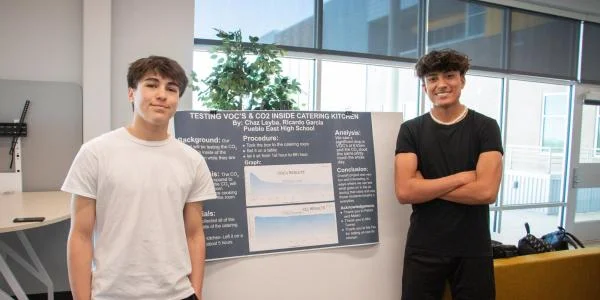CU Boulder and Pueblo’s East High School Introduce SCENIC: A New Approach to Science Class
What is a regular Tuesday for many students at Pueblo East High School is a special day for students in Ms. Turner’s chemistry class. This group of students has been working for the entire semester with CU Boulder graduate students on projects about air quality, and today they get to present their months of hard work to their peers and CU Boulder representatives at a symposium.
The projects stem from a partnership between Pueblo East High School and the Science-Engineering Inquiry Collaborative in Rural Colorado, otherwise known as SCENIC. Developed by Daniel Knight and Michael Hannigan, both professors in CU Boulder’s College of Engineering and Applied Sciences, the SCENIC program aims to provide STEM education resources to underserved, rural K-12 schools. This is achieved with collaborations between the schools and CU Boulder graduate students to create projects that are “student-driven” and “inquiry-based,” per the program’s webpage.
This is the first year the program has partnered with Pueblo East.
“It is always nice to see a school execute a successful first symposium,” said Knight. “Pueblo East pulled it off by conducting well organized, original posters and preparing their students for the presentation.”
This year, students utilized air quality monitoring technology called Pods and developed at CU Boulder to investigate air quality in particular areas of interest related to their lives. Some of the areas students measured were the cafeteria kitchen, the gym and even inside wind instrument. Aunalise Sandoval and Aryonna Pineda decided to measure the air quality at their local zoo.
“We went to different animal exhibits…both indoor and outdoor,” said Aunalise. “The indoor enclosures picked up way more data than the outdoor enclosures did. I really liked this project.”
Both Aunalise and Aryonna said that they had never been to the zoo before this project, and they appreciated the opportunity to explore a new place in their community.
Another valuable aspect of the project was the hands-on experience students had with the Pod.
“It was fun to set it [the Pod] up and see how it collects stuff. I’m kinda used to just doing on-paper stuff. The fact that we got to compare air quality…I’ve never really done a project like that,” said Ricardo Garcia, who chose to measure the air quality in the school’s cafeteria kitchen. “I found it really fun to do and more interesting than just writing stuff down.”
Students in the class learned how to operate the Pod and received guidance on their projects from Patrick Weicko and Mateo Ramis, both CU Boulder graduate students.
“I was really excited to see these pretty shy and reserved students share my excitement in their projects,” Weicko said. “All their ideas had come from personal questions about air quality in their lives, and the questions they had for me really reflected how invested in their projects they were.”
The students shared a similar appreciation for their CU Boulder collaborators.
“They really put a lot of time and effort into the project and helping us,” said Pineda.
Ramis hopes that the program has a lasting impact on the students and their community.
“I come from a really big city, there’s a lot of pollution there, and I don’t think we do much [about it],” said Ramos. “If [the students] get to help people in the future, and it could help air quality wherever they are, I think that would be great.”
Weicko also expressed how essential Emma Turner, the teacher whose classroom the SCENIC project worked with, was to the success of the project. Outside of the times Weicko and Ramis could meet with students, Turner went over the materials and content with the students.
SCENIC wants to integrate high school teachers into the program even more.
“We are looking forward to providing a workshop for our K-12 teachers next year,” said Knight.
For Weicko, SCENIC has also helped shape the future of his professional goals.
“This program has taught me how important these kinds of outreach initiatives are,” said Weicko. “In high school, college was not optional for me, and hearing how many students did not see college as a path they were interested in was eye-opening. I want to continue this sort of outreach through my PhD and onwards, to at least give students an idea of what an engineer/scientist is and hopefully encourage them to go to college.”

